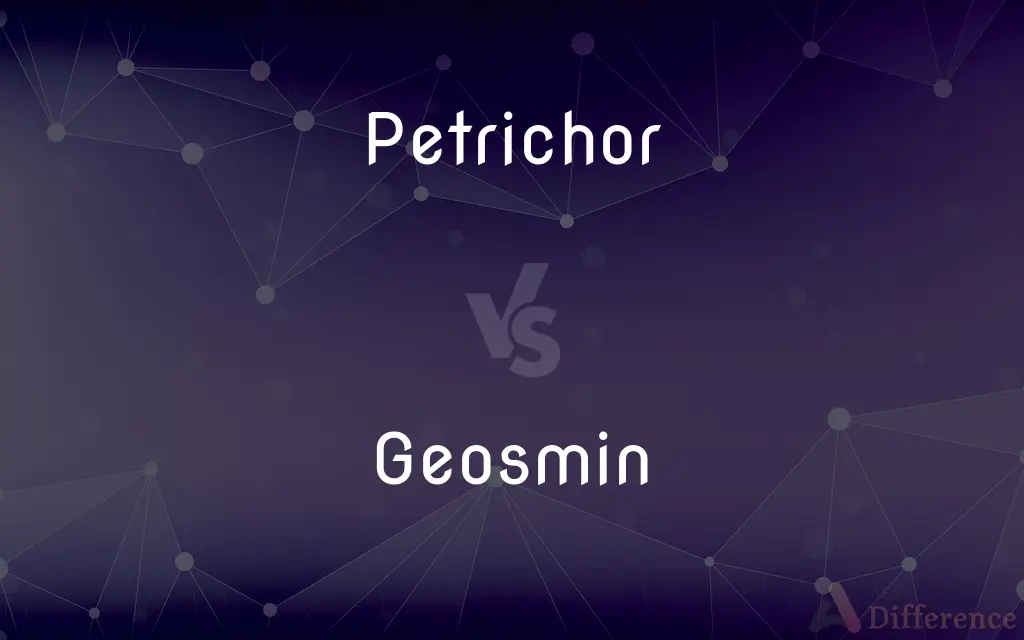Petrichor vs. Geosmin — What's the Difference?
By Fiza Rafique & Urooj Arif — Updated on April 4, 2024
Petrichor is the scent produced when rain falls on dry soil, while geosmin is a compound contributing to that scent.

Difference Between Petrichor and Geosmin
Table of Contents
ADVERTISEMENT
Key Differences
Petrichor encapsulates the pleasant, earthy scent experienced when rain falls on dry soil, a phenomenon often associated with the joy of rain after a long dry spell. This aroma is not only a hallmark of the rainy season but also a complex sensory experience invoking feelings of freshness and renewal. On the other hand, geosmin is a chemical compound produced by soil-dwelling bacteria known as actinobacteria. Geosmin plays a significant role in creating the distinct earthy scent that is a major component of petrichor. While petrichor refers to the overall olfactory experience, geosmin specifically refers to one of the chemical constituents responsible for part of that experience.
Petrichor's charm lies in its ability to evoke a universal response, often seen as soothing and rejuvenating. It is a multisensory phenomenon that includes not only the smell but also the ambiance created by rainfall on dry ground. In contrast, geosmin, despite being less known by name, is immediately recognizable by scent. It is also responsible for the earthy taste of beets and the musty odor of water at times.
The creation of petrichor involves several processes, including the release of oils by plants during dry periods, which are then absorbed by soil and rocks. Rain releases these oils into the air, along with geosmin, to produce the distinctive scent. Geosmin, being water-soluble, is easily aerosolized, allowing its distinct smell to rapidly permeate the air upon the first rain, contributing significantly to the petrichor scent.
Understanding the difference between petrichor and geosmin highlights the intricate relationship between biological and chemical processes in nature that contribute to sensory experiences. While petrichor captures the essence of the rain-soil interaction, geosmin pinpoints the biochemical source of what is arguably petrichor's most characteristic feature.
Both petrichor and geosmin underscore the deep connections humans have with natural phenomena, where a simple chemical compound can evoke profound emotional responses and memories associated with rain. However, petrichor, as a broader sensory and emotional experience, encompasses more than just the smell, reflecting the complex interplay of earth, water, and life.
ADVERTISEMENT
Comparison Chart
Definition
The scent produced when rain falls on dry soil.
A chemical compound contributing to the earthy scent of petrichor.
Origin
Caused by rain releasing oils and compounds like geosmin from the soil.
Produced by actinobacteria in the soil.
Sensory Experience
Encompasses the overall olfactory and emotional experience of rain on dry earth.
Specifically refers to the earthy scent component of petrichor.
Chemical Composition
Involves a mix of several compounds, including plant oils and geosmin.
A singular chemical compound (C12H22O).
Role in Nature
Signals the start of rain, often associated with feelings of renewal.
Contributes to the earthy taste of beets and the musty odor in water.
Compare with Definitions
Petrichor
The distinctive scent produced by rain on dry soil.
The petrichor after the first summer rain refreshed the entire landscape.
Geosmin
A chemical compound that contributes to the earthy scent of petrichor.
The distinct smell of geosmin was unmistakable after the rainfall.
Petrichor
An aromatic phenomenon associated with rainfall.
Petrichor filled the air, reminding everyone of the approaching monsoon.
Geosmin
Produced by soil bacteria, responsible for the musty smell of soil.
Geosmin gives beets their characteristic earthy flavor.
Petrichor
A combination of plant oils, geosmin, and other compounds released by rain.
Petrichor signals the end of a dry spell, filling the air with an earthy aroma.
Geosmin
Responsible for the earthy taste in water at times.
The tap water tasted musty, likely due to high levels of geosmin.
Petrichor
The smell of rain on earth, evoking freshness and nostalgia.
The petrichor evoked memories of rainy days spent at home.
Geosmin
A compound detected by humans at very low concentrations.
Even in small amounts, geosmin's presence is easily recognized due to its potent aroma.
Petrichor
A multisensory experience combining smell, moisture, and the sound of rain.
The petrichor was complemented by the gentle sound of raindrops, creating a perfect moment of peace.
Geosmin
A major component of the scent associated with wet earth.
Geosmin is one of the reasons people love the smell of rain-soaked soil.
Petrichor
The distinctive smell given off by earth, rock, or pavement at the beginning of a rain after a period of warm, dry weather.
Geosmin
Geosmin ( jee-OZ-min) is an irregular sesquiterpene, produced from the universal sesquiterpene precursor farnesyl pyrophosphate (also known as farnesyl diphosphate), in a two-step Mg2+-dependent reaction. Geosmin, along with the irregular monoterpene 2-methylisoborneol, together account for the majority of biologically-caused taste and odor outbreaks in drinking water worldwide.
Petrichor
The organic compounds that produce such a smell.
Geosmin
(organic compound) A bacterial derivative of decahydronaphthalene that has a strong earthy smell and is the material responsible for petrichor.
Geosmin is responsible for the earthy taste of beetroot.
Petrichor
The distinctive scent, caused by geosmin, which accompanies the first rain after a long, warm, dry spell.
Petrichor
The yellow organic oil that yields this scent.
Common Curiosities
What is petrichor and how is it formed?
Petrichor is the scent produced when rain falls on dry soil, formed by the release of plant oils, geosmin, and other compounds.
Can geosmin be harmful to humans?
Geosmin is not harmful to humans; it's recognized for its strong earthy scent and flavor, though it can affect the taste of water and crops like beets.
Why is petrichor associated with positive feelings?
Petrichor evokes feelings of freshness, renewal, and nostalgia, likely tied to its association with rain bringing relief after dry periods.
How can people detect geosmin?
Humans are highly sensitive to geosmin, able to detect it at very low concentrations, often identifying it through its distinct earthy smell.
Are there any benefits to geosmin beyond its scent?
While geosmin is primarily noted for its scent, research into its role in soil and plant health is ongoing, suggesting broader ecological importance.
How do actinobacteria produce geosmin?
Actinobacteria produce geosmin as a byproduct of their metabolic processes, particularly when decomposing organic material in soil.
What is geosmin and where is it found?
Geosmin is a chemical compound produced by soil-dwelling actinobacteria, contributing to the earthy scent of petrichor and found in beets and some water sources.
Why does rain sometimes have a stronger smell of petrichor?
The intensity of petrichor can depend on how long the soil has been dry, the type of soil, and the quantity of rain, influencing the concentration of released compounds.
Can petrichor be captured or recreated?
Scientists and perfumers have studied and recreated the scent of petrichor using similar compounds, including geosmin, for fragrances and research.
Is petrichor present in all types of soil?
Petrichor can be produced in various types of soil, though its intensity may vary depending on the presence of certain bacteria and organic compounds.
Share Your Discovery

Previous Comparison
Sal vs. Saw
Next Comparison
Wizard vs. ClericAuthor Spotlight
Written by
Fiza RafiqueFiza Rafique is a skilled content writer at AskDifference.com, where she meticulously refines and enhances written pieces. Drawing from her vast editorial expertise, Fiza ensures clarity, accuracy, and precision in every article. Passionate about language, she continually seeks to elevate the quality of content for readers worldwide.
Co-written by
Urooj ArifUrooj is a skilled content writer at Ask Difference, known for her exceptional ability to simplify complex topics into engaging and informative content. With a passion for research and a flair for clear, concise writing, she consistently delivers articles that resonate with our diverse audience.















































